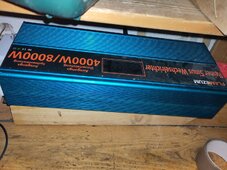doomsdaydevice
New Member
Hi,
I have designed my first small island system as an energy saving / blackout backup.
It consists of a solar input of minimum 300 W (3x100) extendable up to 600W (6x100) all 100 W with the same parameters
I connect them with a Victron MPPT 100 | 50 to a 12V / 400Ah LiFePo Battery Block, which powers a 12/220V inverter with 4000/8000W. The battery block consists of 4 12V100Ah batteries, each able to deliver 100/200Ah. The latter numbers (8000 and 200) are for the up to 5s peak.
So i think, batteries and inverter are harmonized.
Between the charger and the batteries I placed a 40A circuit breaker, to protect it from currencies when a high load is requested from the batteries. The maximum that was requested every now and then is 3500W. The max load currency I observed was with 600W Solar connected around 35A.
The system worked quite well for around a year.
But lately my system showed problems when lots of sun is shining and the batteries had around 70% of load. For example:
- The victron charger detected totally different Voltage values. It switched far to fast between loading phases, to absorption, to float (when it just stopped charging) and once when it reached float it does not register, that the batteries are in use and can be charged again.
- The voltage curves sometimes "flip" around once a minute between 0V and 14V and the charger "makes noises"
- There are other strange observations i havend seen before and when the these strange observations start, I can disconnect the batteries and all solar inputs for a Moment, connect it again and then, for some time everythings switched back to normal, or lets say to what I would expect
When sun is shining, I can lately not connect the full capacity of 600W anymore. Then the problems appear quite fast. With 400W connected, the most common setup, it works mostly, but its winter, so hmmm
The questions I have
How can I ensure, that its the charger and not the batteries, which are broken?
Is it possible, that I fucked it up with a too high load on my batteries and that the 40A circuit breaker was an inappropriate protection for my poor victron charger :-( ?
Any other hints are welcome, I am quite Nooby in this field.
Thx and kind regards
I have designed my first small island system as an energy saving / blackout backup.
It consists of a solar input of minimum 300 W (3x100) extendable up to 600W (6x100) all 100 W with the same parameters
I connect them with a Victron MPPT 100 | 50 to a 12V / 400Ah LiFePo Battery Block, which powers a 12/220V inverter with 4000/8000W. The battery block consists of 4 12V100Ah batteries, each able to deliver 100/200Ah. The latter numbers (8000 and 200) are for the up to 5s peak.
So i think, batteries and inverter are harmonized.
Between the charger and the batteries I placed a 40A circuit breaker, to protect it from currencies when a high load is requested from the batteries. The maximum that was requested every now and then is 3500W. The max load currency I observed was with 600W Solar connected around 35A.
The system worked quite well for around a year.
But lately my system showed problems when lots of sun is shining and the batteries had around 70% of load. For example:
- The victron charger detected totally different Voltage values. It switched far to fast between loading phases, to absorption, to float (when it just stopped charging) and once when it reached float it does not register, that the batteries are in use and can be charged again.
- The voltage curves sometimes "flip" around once a minute between 0V and 14V and the charger "makes noises"
- There are other strange observations i havend seen before and when the these strange observations start, I can disconnect the batteries and all solar inputs for a Moment, connect it again and then, for some time everythings switched back to normal, or lets say to what I would expect
When sun is shining, I can lately not connect the full capacity of 600W anymore. Then the problems appear quite fast. With 400W connected, the most common setup, it works mostly, but its winter, so hmmm
The questions I have
How can I ensure, that its the charger and not the batteries, which are broken?
Is it possible, that I fucked it up with a too high load on my batteries and that the 40A circuit breaker was an inappropriate protection for my poor victron charger :-( ?
Any other hints are welcome, I am quite Nooby in this field.
Thx and kind regards







